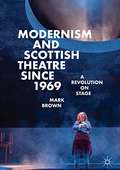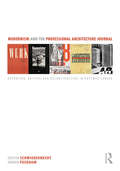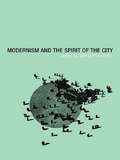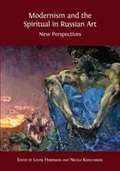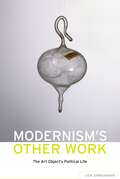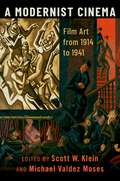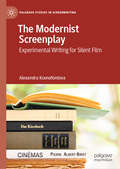- Table View
- List View
Modernism and Scottish Theatre since 1969: A Revolution on Stage
by Mark BrownThis book argues that Scottish theatre has, since the late 1960s, undergone an artistic renaissance, driven by European Modernist aesthetics. Combining detailed research and analysis with exclusive interviews with ten leading figures in modern Scottish drama, the book sets out the case for the last half-century as the strongest period in the history of the Scottish stage. Mark Brown traces the development of Scottish theatre’s Modernist revolution from the arrival of influential theatre director Giles Havergal at the Citizens Theatre, Glasgow in 1969 through to the advent of the National Theatre of Scotland in 2006. Finally, the book contemplates the future of Scotland’s theatrical renaissance. It is essential reading for anyone interested in contemporary theatre and/or the modern history of live drama in Scotland.
Modernism and the making of the Soviet New Man (Social And Political Power Ser.)
by Tijana VujoševicModernism and the Making of the New Man is a history or Soviet architecture that is unique in that, instead of styles or great architects, it focuses on the design of communist subjectivity – the notion of the “new man”.
Modernism and the making of the Soviet New Man
by Tijana VujoševicModernism and the Making of the New Man is a history or Soviet architecture that is unique in that, instead of styles or great architects, it focuses on the design of communist subjectivity – the notion of the “new man”.
Modernism and the Professional Architecture Journal: Reporting, Editing and Reconstructing in Post-War Europe
by Torsten Schmiedeknecht Andrew PeckhamThe production of this book stems from two of the editors’ longstanding research interests: the representation of architecture in print media, and the complex identity of the second phase of modernism in architecture given the role it played in postwar reconstruction in Europe. While the history of postwar reconstruction has been increasingly well covered for most European countries, research investigating postwar architectural magazines and journals across Europe – their role in the discourse and production of the built environment and particularly their inter-relationship and differing conceptions of postwar architecture – is relatively undeveloped. Modernism and the Professional Architecture Journal sounds out this territory in a new collection of essays concerning the second phase of the reception and assimilation of modernism in architecture, as it was represented in professional architecture journals during the period of postwar reconstruction (1945–1968). Professional architecture journals are often seen as conduits of established facts and knowledge. The role mainstream publications play, however, in establishing ‘movements’, ‘trends’ or ‘debates’ tends to be undervalued. In the context of the complex undertaking of postwar reconstruction, the shortage of resources, political uncertainty and the biographical complexities of individual architects, the chapters on key European architecture journals collected here reveal how modernist architecture, and its discourse, was perceived and disseminated in different European countries.
Modernism and the Professional Architecture Journal: Reporting, Editing and Reconstructing in Post-War Europe
by Torsten Schmiedeknecht Andrew PeckhamThe production of this book stems from two of the editors’ longstanding research interests: the representation of architecture in print media, and the complex identity of the second phase of modernism in architecture given the role it played in postwar reconstruction in Europe. While the history of postwar reconstruction has been increasingly well covered for most European countries, research investigating postwar architectural magazines and journals across Europe – their role in the discourse and production of the built environment and particularly their inter-relationship and differing conceptions of postwar architecture – is relatively undeveloped. Modernism and the Professional Architecture Journal sounds out this territory in a new collection of essays concerning the second phase of the reception and assimilation of modernism in architecture, as it was represented in professional architecture journals during the period of postwar reconstruction (1945–1968). Professional architecture journals are often seen as conduits of established facts and knowledge. The role mainstream publications play, however, in establishing ‘movements’, ‘trends’ or ‘debates’ tends to be undervalued. In the context of the complex undertaking of postwar reconstruction, the shortage of resources, political uncertainty and the biographical complexities of individual architects, the chapters on key European architecture journals collected here reveal how modernist architecture, and its discourse, was perceived and disseminated in different European countries.
Modernism and the Spirit of the City
by Iain Boyd WhyteModernism and the Spirit of the City offers a new reading of the architectural modernism that emerged and flourished in Europe in the first half of the twentieth century. Rejecting the fashionable postmodernist arguments of the 1980s and '90s which damned modernist architecture as banal and monotonous, this collection of essays by eminent scholars investigates the complex cultural, social, and religious imperatives that lay below the smooth, white surfaces of new architecture.
Modernism and the Spirit of the City
by Iain Boyd WhyteModernism and the Spirit of the City offers a new reading of the architectural modernism that emerged and flourished in Europe in the first half of the twentieth century. Rejecting the fashionable postmodernist arguments of the 1980s and '90s which damned modernist architecture as banal and monotonous, this collection of essays by eminent scholars investigates the complex cultural, social, and religious imperatives that lay below the smooth, white surfaces of new architecture.
Modernism and the Spiritual in Russian Art: New Perspectives (PDF)
by Louise Hardiman Nicola KozicharowIn 1911 Vasily Kandinsky published the first edition of ‘On the Spiritual in Art’, a landmark modernist treatise in which he sought to reframe the meaning of art and the true role of the artist. For many artists of late Imperial Russia – a culture deeply influenced by the regime’s adoption of Byzantine Orthodoxy centuries before – questions of religion and spirituality were of paramount importance. As artists and the wider art community experimented with new ideas and interpretations at the dawn of the twentieth century, their relationship with ‘the spiritual’ – broadly defined – was inextricably linked to their roles as pioneers of modernism. This diverse collection of essays introduces new and stimulating approaches to the ongoing debate as to how Russian artistic modernism engaged with questions of spirituality in the late nineteenth to mid-twentieth centuries. Ten chapters from emerging and established voices offer new perspectives on Kandinsky and other familiar names, such as Kazimir Malevich, Mikhail Larionov, and Natalia Goncharova, and introduce less well-known figures, such as the Georgian artists Ucha Japaridze and Lado Gudiashvili, and the craftswoman and art promoter Aleksandra Pogosskaia. Prefaced by a lively and informative introduction by Louise Hardiman and Nicola Kozicharow that sets these perspectives in their historical and critical context, Modernism and the Spiritual in Russian Art: New Perspectives enriches our understanding of the modernist period and breaks new ground in its re-examination of the role of religion and spirituality in the visual arts in late Imperial Russia. Of interest to historians and enthusiasts of Russian art, culture, and religion, and those of international modernism and the avant-garde, it offers innovative readings of a history only partially explored, revealing uncharted corners and challenging long-held assumptions.
Modernism in Art, Design and Architecture
by Christopher CrouchThis text summarises and contextualises the ideas that formed visual arts practices this century. Art, design and architecture are located in their social and political contexts, and the ideas of modernism are traced from the development of industrialised Europe at the turn of the century to the post-industrial, post-colonial present. The complex relationship between modernism and postmodernism in the visual arts is examined and the book concludes with a review of the global impact of the new technologies on art and design production.
Modernism in Late-Mao China: Architecture for Foreign Affairs in Beijing, Guangzhou and Overseas, 1969–1976 (Routledge Research in Architecture)
by Ke SongThis book investigates the architectural history of China in the Mao era (1949–1976), focusing on the rise of modernism in the last seven years of the Cultural Revolution from 1969 to 1976. It highlights the new architecture of this period, exemplified by three clusters of buildings for foreign affairs, namely buildings for foreign diplomacy in Beijing, buildings for foreign trade in Guangzhou and China’s foreign aid projects overseas. The emergence of new architecture in the early 1970s is closely associated with China’s political and diplomatic shift of the time, from a radical emphasis on ideological struggle to a dynamic balance between leftist ideology and pragmatic concerns. In this context, China’s relations with the West quickly improved, culminating with American president Richard Nixon’s visit to China in 1972. The increasing foreign affairs brought new opportunities to Chinese architects who referenced both Western modernism and Chinese architectural traditions to create a new version of Chinese modernism. The book brings dimensions of form, politics and knowledge to the analysis of architecture, to construct an understanding of architectural design as an aesthetic, political and intellectual practice. Modernism in Late-Mao China will be an enriching and useful reference for students and scholars who are interested in the global architectural history of the twentieth century, especially Cold War modernism.
Modernism in Late-Mao China: Architecture for Foreign Affairs in Beijing, Guangzhou and Overseas, 1969–1976 (Routledge Research in Architecture)
by Ke SongThis book investigates the architectural history of China in the Mao era (1949–1976), focusing on the rise of modernism in the last seven years of the Cultural Revolution from 1969 to 1976. It highlights the new architecture of this period, exemplified by three clusters of buildings for foreign affairs, namely buildings for foreign diplomacy in Beijing, buildings for foreign trade in Guangzhou and China’s foreign aid projects overseas. The emergence of new architecture in the early 1970s is closely associated with China’s political and diplomatic shift of the time, from a radical emphasis on ideological struggle to a dynamic balance between leftist ideology and pragmatic concerns. In this context, China’s relations with the West quickly improved, culminating with American president Richard Nixon’s visit to China in 1972. The increasing foreign affairs brought new opportunities to Chinese architects who referenced both Western modernism and Chinese architectural traditions to create a new version of Chinese modernism. The book brings dimensions of form, politics and knowledge to the analysis of architecture, to construct an understanding of architectural design as an aesthetic, political and intellectual practice. Modernism in Late-Mao China will be an enriching and useful reference for students and scholars who are interested in the global architectural history of the twentieth century, especially Cold War modernism.
Modernism in Scandinavia: Art, Architecture and Design
by Charlotte AshbyScandinavia is a region associated with modernity: modern design, modern living and a modern welfare state. This new history of modernism in Scandinavia offers a picture of the complex reality that lies behind the label: a modernism made up of many different figures, impulses and visions. It places the individuals who have achieved international fame, such as Edvard Munch and Alvar Aalto in a wider context, and through a series of case studies, provides a rich analysis of the art, architecture and design history of the Nordic region, and of modernism as a concept and mode of practice.Modernism in Scandinavia addresses the decades between 1890 and 1970 and presents an intertwined history of modernism across the region. Charlotte Ashby gives a rationale for her focus on those countries which share an interrelated history and colonial past, but also stresses influences from outside the region, such as the English Arts and Crafts movement and the impact of emergent American modernism. Her richly illustrated account guides the reader through key historical periods and cultural movements, with case studies illuminating key art works, buildings, designed products and exhibitions.
Modernism in Scandinavia: Art, Architecture and Design
by Charlotte AshbyScandinavia is a region associated with modernity: modern design, modern living and a modern welfare state. This new history of modernism in Scandinavia offers a picture of the complex reality that lies behind the label: a modernism made up of many different figures, impulses and visions. It places the individuals who have achieved international fame, such as Edvard Munch and Alvar Aalto in a wider context, and through a series of case studies, provides a rich analysis of the art, architecture and design history of the Nordic region, and of modernism as a concept and mode of practice.Modernism in Scandinavia addresses the decades between 1890 and 1970 and presents an intertwined history of modernism across the region. Charlotte Ashby gives a rationale for her focus on those countries which share an interrelated history and colonial past, but also stresses influences from outside the region, such as the English Arts and Crafts movement and the impact of emergent American modernism. Her richly illustrated account guides the reader through key historical periods and cultural movements, with case studies illuminating key art works, buildings, designed products and exhibitions.
Modernism versus Traditionalism: Art in Paris, 1888-1889
by Nicolas W. Proctor Gretchen K. McKay Michael A. MarlaisModernism vs. Traditionalism: Art in Paris 1888-1889 considers questions surrounding artistic developments at the end of the nineteenth century in Paris. Students will debate principles of artistic design in the context of the revolutionary changes that began shaking the French art world in 1888-1889. Images from the 1888 Salon and the tumultuous year that followed provide some of the "texts" that form the intellectual heart of every reacting game. Styles include conservative art espoused by the Academy, as well as more avant-garde art created by artists such as Van Gogh and Gauguin. Also included are the Impressionists and American artists in Paris. Students must read paintings as texts and use them as the basis of their positions in advocating for the future of art. In addition to these visual texts, students will read art criticism from the period, which will help form the basis of their own presentations in favor of one art style over another. These discussions are complicated and enriched by secondary debates over the economics of art, the rise of independent art dealers, and the government's role as a patron of the arts. The game culminates at the 1889 World Exposition in Paris.
Modernism's Other Work: The Art Object's Political Life
by Lisa SiraganianModernism's Other Work challenges deeply held critical beliefs about the meaning-in particular the political meaning-of modernism's commitment to the work of art as an object detached from the world. Ranging over works of poetry, fiction, painting, sculpture, and film, it argues that modernism's core aesthetic problem-the artwork's status as an object, and a subject's relation to it-poses fundamental questions of agency, freedom, and politics. With fresh accounts of works by canonical figures such as William Carlos Williams and Marcel Duchamp, and transformative readings of less-studied writers such as William Gaddis and Amiri Baraka, Siraganian reinterprets the relationship between aesthetic autonomy and politics. Through attentive readings, the study reveals how political questions have always been modernism's critical work, even when writers such as Gertrude Stein and Wyndham Lewis boldly assert the art object's immunity from the world's interpretations. Reorienting our understanding of the period, Siraganian demonstrates that the freedom of the art object from the reader's meaning presented a way to imagine an individual's complicated liberty within the state. Offering readers an original encounter with modernism, Modernism's Other Work will interest literary and art historians, literary theorists, critics, and scholars in cultural studies.
Modernism's Other Work: The Art Object's Political Life
by Lisa SiraganianModernism's Other Work challenges deeply held critical beliefs about the meaning-in particular the political meaning-of modernism's commitment to the work of art as an object detached from the world. Ranging over works of poetry, fiction, painting, sculpture, and film, it argues that modernism's core aesthetic problem-the artwork's status as an object, and a subject's relation to it-poses fundamental questions of agency, freedom, and politics. With fresh accounts of works by canonical figures such as William Carlos Williams and Marcel Duchamp, and transformative readings of less-studied writers such as William Gaddis and Amiri Baraka, Siraganian reinterprets the relationship between aesthetic autonomy and politics. Through attentive readings, the study reveals how political questions have always been modernism's critical work, even when writers such as Gertrude Stein and Wyndham Lewis boldly assert the art object's immunity from the world's interpretations. Reorienting our understanding of the period, Siraganian demonstrates that the freedom of the art object from the reader's meaning presented a way to imagine an individual's complicated liberty within the state. Offering readers an original encounter with modernism, Modernism's Other Work will interest literary and art historians, literary theorists, critics, and scholars in cultural studies.
A Modernist Cinema: Film Art from 1914 to 1941
by Scott W. Klein and Michael Valdez MosesIn A Modernist Cinema, sixteen distinguished scholars in the field of the New Modernist Studies explore the interrelationships among modernism, cinema, and modernity. Focusing on several culturally influential films from Europe, America, and Asia produced between 1914 and 1941, this collection of essays contends that cinema was always a modernist enterprise. Examining the dialectical relationship between a modernist cinema and modernity itself, these essays reveal how the movies represented and altered our notions and practices of modern life, as well as how the so-called crises of modernity shaped the evolution of filmmaking. Attending to the technical achievements and formal qualities of the works of several prominent directors - Giovanni Pastrone, D. W. Griffith, Sergei Eisenstein, Fritz Lang, Alfred Hitchcock, F. W. Murnau, Carl Theodore Dreyer, Dziga Vertov, Luis Buñuel, Yasujiro Ozu, John Ford, Jean Renoir, Charlie Chaplin, Leni Riefenstahl, and Orson Welles - these essays investigate several interrelated topics: how a modernist cinema represented and intervened in the political and social struggles of the era; the ambivalent relationship between cinema and the other modernist arts; the controversial interconnection between modern technology and the new art of filmmaking; the significance of representing the mobile human body in a new medium; the gendered history of modernity; and the transformative effects of cinema on modern conceptions of temporality, spatial relations, and political geography.
A Modernist Cinema: Film Art from 1914 to 1941
In A Modernist Cinema, sixteen distinguished scholars in the field of the New Modernist Studies explore the interrelationships among modernism, cinema, and modernity. Focusing on several culturally influential films from Europe, America, and Asia produced between 1914 and 1941, this collection of essays contends that cinema was always a modernist enterprise. Examining the dialectical relationship between a modernist cinema and modernity itself, these essays reveal how the movies represented and altered our notions and practices of modern life, as well as how the so-called crises of modernity shaped the evolution of filmmaking. Attending to the technical achievements and formal qualities of the works of several prominent directors - Giovanni Pastrone, D. W. Griffith, Sergei Eisenstein, Fritz Lang, Alfred Hitchcock, F. W. Murnau, Carl Theodore Dreyer, Dziga Vertov, Luis Buñuel, Yasujiro Ozu, John Ford, Jean Renoir, Charlie Chaplin, Leni Riefenstahl, and Orson Welles - these essays investigate several interrelated topics: how a modernist cinema represented and intervened in the political and social struggles of the era; the ambivalent relationship between cinema and the other modernist arts; the controversial interconnection between modern technology and the new art of filmmaking; the significance of representing the mobile human body in a new medium; the gendered history of modernity; and the transformative effects of cinema on modern conceptions of temporality, spatial relations, and political geography.
Modernist Diaspora: Immigrant Jewish Artists in Paris, 1900-1945
by Richard D. SonnIn the years before, during, and after the First World War, hundreds of young Jews flocked to Paris, artistic capital of the world and center of modernist experimentation. Some arrived with prior training from art academies in Kraków, Vilna, and Vitebsk; others came armed only with hope and a few memorized phrases in French. They had little Jewish tradition in painting and sculpture to draw on, yet despite these obstacles, these young Jews produced the greatest efflorescence of art in the long history of the Jewish people.The paintings of Marc Chagall, Amedeo Modigliani, Chaim Soutine, Sonia Delaunay-Terk, and Emmanuel Mané-Katz, the sculptures of Jacques Lipchitz, Ossip Zadkine, Chana Orloff, and works by many other artists now grace the world's museums. As the École de Paris was the most cosmopolitan artistic movement the world had seen, the left-bank neighborhood of Montparnasse became a meeting place for diverse cultures.How did the tolerant, bohemian atmosphere of Montparnasse encourage an international style of art in an era of bellicose nationalism, not to mention racism and antisemitism? How did immigrants not only absorb but profoundly influence a culture? This book examines how the clash of cultures produced genius.
Modernist Diaspora: Immigrant Jewish Artists in Paris, 1900-1945
by Richard D. SonnIn the years before, during, and after the First World War, hundreds of young Jews flocked to Paris, artistic capital of the world and center of modernist experimentation. Some arrived with prior training from art academies in Kraków, Vilna, and Vitebsk; others came armed only with hope and a few memorized phrases in French. They had little Jewish tradition in painting and sculpture to draw on, yet despite these obstacles, these young Jews produced the greatest efflorescence of art in the long history of the Jewish people.The paintings of Marc Chagall, Amedeo Modigliani, Chaim Soutine, Sonia Delaunay-Terk, and Emmanuel Mané-Katz, the sculptures of Jacques Lipchitz, Ossip Zadkine, Chana Orloff, and works by many other artists now grace the world's museums. As the École de Paris was the most cosmopolitan artistic movement the world had seen, the left-bank neighborhood of Montparnasse became a meeting place for diverse cultures.How did the tolerant, bohemian atmosphere of Montparnasse encourage an international style of art in an era of bellicose nationalism, not to mention racism and antisemitism? How did immigrants not only absorb but profoundly influence a culture? This book examines how the clash of cultures produced genius.
Modernist Magazines and the Social Ideal
by Tim SatterthwaiteThe new photo-illustrated magazines of the 1920s traded in images of an ideal modernity, promising motorised leisure, scientific progress, and social and sexual emancipation. Modernist Magazines and the Social Ideal is a pioneering history of these periodicals, focusing on two of the leading European titles: the German monthly UHU, and the French news weekly VU, taken as representative of the broad class of popular titles launched in the 1920s. The book is the first major study of UHU, and the first scholarly work on VU in English. The book explores, in particular, the striking use of regularity and repetition in photographs of modernity, reading these repetitious images as symbolic of modernist ideals of social order in the aftermath of the First World War. Alongside the UHU and VU case studies, Modernist Magazines offers an essential primer to interwar magazine culture in Europe. Accounts of rival titles are woven into the book's thematic chapters, which trace the evolution of the two magazines' photography and graphic design in the tumultuous years up to 1933.
Modernist Magazines and the Social Ideal (Criminal Practice Ser.)
by Tim SatterthwaiteThe new photo-illustrated magazines of the 1920s traded in images of an ideal modernity, promising motorised leisure, scientific progress, and social and sexual emancipation. Modernist Magazines and the Social Ideal is a pioneering history of these periodicals, focusing on two of the leading European titles: the German monthly UHU, and the French news weekly VU, taken as representative of the broad class of popular titles launched in the 1920s. The book is the first major study of UHU, and the first scholarly work on VU in English. The book explores, in particular, the striking use of regularity and repetition in photographs of modernity, reading these repetitious images as symbolic of modernist ideals of social order in the aftermath of the First World War. Alongside the UHU and VU case studies, Modernist Magazines offers an essential primer to interwar magazine culture in Europe. Accounts of rival titles are woven into the book's thematic chapters, which trace the evolution of the two magazines' photography and graphic design in the tumultuous years up to 1933.
Modernist Patterns: in Literature and the Visual Arts
by M. RostonIn this stimulating study, the author explores how Conrad, T.S.Eliot, Woolf, Joyce, Faulkner, Hemingway, Huxley and others responded to the immediate challenges of their time, to the implications of Freudian psychology, molecular theory, relativist theory, and the general weakening of religious faith. Assuming that artists and writers, in coping with those problems, would develop techniques in many ways comparable, even where there was no direct contact, he positions Modernist literature within the context of contemporary painting, architecture and sculpture, thereby providing some fascinating insights into the nature of the literary works themselves.
The Modernist Screenplay: Experimental Writing for Silent Film (Palgrave Studies in Screenwriting)
by Alexandra KsenofontovaThe Modernist Screenplay explores the film screenplay as a genre of modernist literature. It connects the history of screenwriting for silent film to the history of literary modernism in France, Germany, and Russia. At the same time, the book considers how the screenplay responded to the modernist crisis of reason, confronted mimetic representation, and sought to overcome the modernist mistrust of language with the help of rhythm. From the silent film projects of Bertolt Brecht, to the screenwriting of Sergei Eisenstein and the poetic scripts of the surrealists, The Modernist Screenplay offers a new angle on the relationship between film and literature. Based on the example of modernist screenwriting, the book proposes a pluralistic approach to screenplays, an approach that sees film scripts both as texts embedded in film production and as literary works in their own right. As a result, the sheer variety of different and experimental ways to tell stories in screenplays comes to light. The Modernist Screenplay explores how the earliest kind of experimental screenplays—the modernist screenplays—challenged normative ideas about the nature of filmmaking, the nature of literary writing, and the borders between the two.
Modernist Semis and Terraces in England (Ashgate Studies in Architecture)
by Finn JensenBetween the two World Wars, there was an unprecedented need for new houses in Britain which resulted in a building boom. While only a small percentage of this building took the form of Modernism, there was still a significant number of semis and terraces built for the workers and middle-class families in the 1920s and 1930s built in this style. This book examines these modest Modernist houses within the broader context of the Modern Movement in Europe, as well as the inter-war building boom in suburban Britain. Illustrated with line drawings and photographs of more than 30 examples from around the country, and based on little-known contemporary material such as catalogues, advertisements, radio broadcasts and letters, it shows how these houses speak of a time of political, social and artistic unrest, and a world where the avant-garde architects sought to capture the spirit of modern technology in their designs for the average home owner. While the Modernist houses never became popular with the general public, the fact that so many are still standing and now sought after by twenty-first century families speak for their endurance and special appeal.
